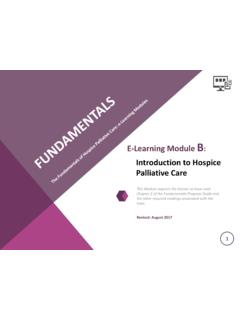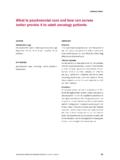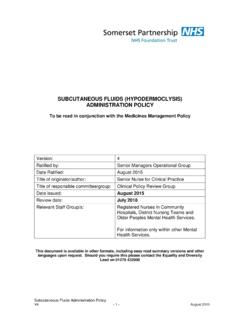Transcription of Pain Management - The Palliative Care Bridge
1 pain Management in Palliative care pain in Palliative care pain assessment in Palliative care Strategies for pain Management Other symptoms pain Management in Palliative care is produced by Hammond care Originally produced in New Zealand for bpacNZ with content provided by Rod MacLeod, Carol McAllum and Tom Swire. Revised in 2014 by Rod MacLeod, with permission pain Management in Palliative care | 1. pain Management in Palliative care Contents 4 Professor Rod MacLeod Lessons learned 5 pain in Palliative care 6 pain assessment in Palliative care 10 Strategies for total pain Management The WHO analgesic ladder.
2 Starting oral morphine. Morphine titration. Switching to slow release morphine. Opioid tolerance and dependence. Breakthrough and incident pain . Management of opioid induced adverse effects. Alternative opioids. Adjuvant therapies. Neuropathic pain . Corticosteroids. 20 Other symptoms Dyspnoea. Cough. Constipation. Hiccups. Retained secretions (death rattle). Xerostomia and stomatitis. Pruritus. 25 Syringe drivers in Palliative care 26 Useful resources The information in this publication is specifically designed to address conditions and requirements in Australia and no other country.
3 HammondCare assumes no responsibility for action or inaction by any other party based on the information found in this publication and readers are urged to seek appropriate professional advice before acting on this. pain Management in Palliative care | 2. Key messages Adopt a systematic whole person approach to total pain assessment and Management Administer regular analgesia in accordance with the WHO. analgesic ladder Use appropriate adjuvant therapies as specifically indicated at any time during the illness Liaise with the Palliative care team as soon as it becomes apparent that specialist advice may be needed Maintain involvement with the patient throughout their illness pain Management in Palliative care | 3.
4 Professor Rod MacLeod Lessons Learned We asked Rod, Conjoint Professor of Palliative care at the University of Sydney and Senior Staff Specialist in Palliative care for HammondCare, what lessons for primary care he had learned on his journey from rural practice in East Anglia, UK to his present day work in North Sydney, Australia. His reply was that he had come to understand that for patients receiving Palliative care , maintaining relationships and continuing normal daily activities are just as important, if not more so, than symptom control.
5 This understanding is the cornerstone of successful Palliative care . Both Palliative care and primary care are about people and their families, listening to them and learning what is most meaningful in their lives. Primary care clinicians have the advantage over those who work solely in Palliative care of being able to build up high levels of expertise about their individual patients through years of shared experiences and mutual trust. For patients receiving Palliative care , maintaining relationships and continuing normal daily activities are just as important, if not more so, than symptom control.
6 This premise is the cornerstone of successful Palliative care . Rod feels that general practitioners and others working in primary care often underestimate both how much they know about their patients and the importance of their role in caring for people receiving Palliative care . He is not just talking about peoples' physical wellbeing and how they respond to ill health but the context of their lives and what is most meaningful to them. The sadness is when people are admitted to a hospice or hospital this expertise is often no longer available to guide patient care .
7 Approximately 90% of Palliative care takes place in the home and there is a growing body of evidence that people who are cared for at home by a team that includes the patient's own general practitioner achieve good outcomes with significantly reduced hospital admissions. The key attributes to making this work are communication, competence and confidence. Communication with patients is what general practitioners are good at. Communication with other health professionals can be more problematic. Often busy-ness gets in the way.
8 Rod hopes that GPs will see this guide as an aid to providing best possible care when and where it is needed. Competence in managing the common symptoms associated with Palliative care is not difficult to achieve for most situations. Uncomplicated approaches to the physical aspects of pain , dyspnoea and nausea are usually successful but Management of the fear and distress that often accompanies these symptoms needs a more intimate and individualised approach. Confidence grows with knowledge and the experience of working alongside other members of the primary and Palliative care teams.
9 The early establishment of working relationships and pathways will ensure clinicians are not left isolated and can readily obtain advice when they need it. These attributes enable primary care clinicians to improve the quality of life of people receiving Palliative care by helping them to maintain relationships and continue with normal daily activities as well as achieving good symptom control. pain Management in Palliative care | 4. pain in Palliative care Palliative care involves assessing and managing pain that may: Be persistent Have multiple aetiologies, one or more of which are incurable Impair function Threaten independence, and, Invoke fear of further suffering and death pain will trouble over half of patients with advanced cancer, AIDS, cardiac disease or neurological disorders.
10 However, pain is not inevitable in these diseases. Approximately 30% of patients with advanced cancer will not get severe pain , 80%. of those who do can achieve good pain relief by the systematic use of oral analgesia, appropriate adjuvant therapies and multi-faceted supportive strategies. The aim is to optimise quality of life right up to the moment of death. pain Management in Palliative care | 5. pain assessment in Palliative care A whole person approach to pain assessment can be assisted by considering four components of the pain experience: 1.





